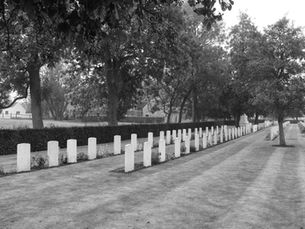top of page

Welcome to the Ypres Salient
This site presents the story of the First World War in the West Flanders region. The various categories provide a wealth of information about a range of subjects.
The Roll of Honour category is where you will find the details of all the men from Falkirk District who are buried or commemorated in the Immortal Salient.
Sharing history Sharing knowledge Learn more
Search


Dragoon Camp Cemetery
Dragoon Camp Cemetery, CWGC, This was behind German lines until the opening day of Third Battle of Ypres on 31 July when the site was taken by the 38th (Welsh) Division and the cemetery, called at first the Villa Gretchen Cemetery, was begun by the 13th Battalion Royal Welch Fusiliers on 9 August. It continued in use until October 1917. It seems likely that the burial party form the 13th Royal Welch Fusiliers buried up to forty bodies here that had lain on the battlefield for
Dec 65 min read


La Belle Alliance Cemetery
La Belle Alliance Cemetery was made in February and March 1916, by the 10th and 11th Battalions King's Royal Rifle Corps, 59th Infantry Brigade, 20th (Light) Division and was used again in July and August 1917. It was originally named from a farmhouse which used to stand some two hundred yards to the north east. The cemetery is located on Coney Street which was one of the communication trenches. This area was also a major hub for rail and tramway traffic, guns sites, and Fiel
Nov 144 min read


Divisional Collecting Post Cemetery & Extension
The CWGC Divisional Collecting Post Cemetery was begun by field ambulances of the 48th (South Midland) and 58th (2/1st London) Divisions in August 1917. It continued in use until January 1918 and at the Armistice contained 86 graves. The Cemetery and Extension are within the same boundary wall and are considered to be one cemetery. Between 1924 and 1926, the original cemetery was considerably enlarged when graves were brought in from the surrounding battlefields
Nov 1411 min read


Track X Cemetery
The site of Track X CWGC cemetery was in No Man’s Land in June 1917 and the trenches in this area were no more than one hundred yards apart. The cemetery was begun by the 39th and 48th (South Midland) Divisions at the end of July, after Commonwealth forces advanced on this front. It was closed in November 1917, except for two burials in May 1918.
Nov 67 min read


Buffs Road Cemetery
Buffs Road was the name given to a small lane, which ran between Boundary Road and Admiral's Road, just to the north of the hamlet of Wieltje. This is a battlefield burial ground and was in No Man’s Land before the Third Battle of Ypres began on 31 July 1917. The cemetery was made and used by fighting units, in particular by the 12th, 13th and 14th Royal Sussex Regiment, and the Royal Field Artillery and Royal Garrison Artillery between July 1917 and March 1918.
Oct 308 min read


Bridge House Cemetery
Bridge House Cemetery is one of the smallest CWGC cemeteries in the Ypres Salient. The nearby farm was part of the German Second Line at the start of the Third Battle of Ypres and was taken on the first day of the battle, 31 July 1917 by the 55th (West Lancashire) Division. The farm was regularly used as a dressing station by various units however, it was the 59th (North Midland) Division Field Ambulance who established a cemetery here at the end of September 1917.
Oct 265 min read


La Brique Military Cemetery No.2
La Brique is a small hamlet named from an old brick works that used to stand nearby before the First World War. La Brique Military Cemetery No.2 was begun in February 1915 and used until March 1918. The original cemetery consisted of 383 burials laid out in 25 irregular rows in Plot I. After the Armistice, graves were brought in from the battlefields to create Plot II and extend the original Plot I.
Oct 2410 min read


La Brique Military Cemetery No.1
La Brique is a small hamlet named from an old brick works that used to stand nearby before the First World War. La Brique No.1 was begun in May 1915 when the 6th Division took over the line here from the 4th Division, and was used until the following December. La Brique Military Cemetery No 1 is the smaller of the two cemeteries and is opposite La Brique Military Cemetery No 2.
Oct 183 min read


Tuileries British Cemetery
The Tuileries, or tile-works named Tuileries by the French Corps de Moussy when staying here, was located a little north-west of Zillebeke village, today with the expansion of the village it is within the boundaries, and in 1915, a number of Commonwealth and French soldiers were buried here. The cemetery had some of the earliest British burials, 106 buried here, however, 80 of the 106 graves were destroyed and lost when the cemetery was very badly shelled.
Sep 137 min read


Kemmel No.1 French Cemetery
This is a front line cemetery and of great interest. In April 1918, this sector and the nearby villages of Vierstraat and Kemmel were the scene of fierce fighting in which both Commonwealth and French forces were engaged. From 26 April to the end of August, the villages were in German hands. The Commonwealth War Graves Commission state that the origin of the cemetery is not known; it was found by the French Graves Services soon after the Armistice and contained Commonwealth,
Sep 129 min read


Godezonne Farm Cemetery
The cemetery was made in the garden of Godezonne Farm, between February and May 1915 by the 2nd Royal Scots and the 4th Middlesex both of 8th Infantry Brigade, 3rd Division. The cemetery is on the road that was known as Cheapside. Three further burials were added in 1916 and the cemetery was enlarged after the Armistice when fifty-nine graves were brought in from a wide area north and east of Kemmel. Further along the road you will find the memorial to the men of the 32nd Fre
Sep 810 min read


Suffolk Cemetery
This cemetery was begun in March and April 1915 by the 2nd Battalion Suffolk Regiment, 8th Infantry Brigade, 3rd Division. Apart from one burial made in November 1917, the cemetery was not used again until October 1918 when the 38th Labour Group buried twenty-eight men killed during the German advance the previous April, all but two of whom belonged to the 1st/4th and 1st/5th York and Lancasters. At this time, the cemetery was called Cheapside Cemetery after the nearby road.
Sep 55 min read


Elzenwalle Brasserie Cemetery
There used to be a lot of alder trees, elzen in Flemish, in the area which were commonly found in wetland. The wood is a soft hardwood used for making furniture, cabinets, charcoal and clogs. This cemetery is named after a brewery, the Kemmel Brouwerij, which stood opposite and is in fact a collection of small regimental burial grounds, of which Plot III in particular was made by the 22nd Battalion Canadian Infantry (Quebec Regt). The eight plots are numbered neither in order
Sep 47 min read


Dickebusch Old Military Cemetery
The Old Military Cemetery was used as a front line cemetery from January to March 1915. The cemetery contains 46 First World War burials. There are also ten burials from the Second World War, all dating from late May 1940 when the British Expeditionary Force withdrew ahead of the German advance. The seventy-eight French graves were removed after the Armistice. There were three officers buried in Dickebusch Churchyard an
Aug 306 min read


Cabin Hill Cemetery
Wytschaete (now Wijtschate) was taken by the Germans early in November 1914. It was recovered by Commonwealth forces during the Battle of Messines on 7 June 1917, but fell into German hands once more on 16 April 1918. The village was recovered for the last time on 28 September 1918. Cabin Hill Cemetery was begun by the 11th Division in June 1917 and used as a front line cemetery until March 1918. In October 1914, the 9th (Queen’s Royal) Lancers held the line here.
Aug 294 min read


Croonaert Chapel Cemetery
This is a cemetery that is very rarely visited. Croonaert Chapel was a shrine in a hamlet on the Wytschaete-Voormezeele road, and was in No Man's Land before the Battle of Messines in June 1917. The cemetery was begun by the 19th Division Burial Officer in June 1917, and used until the following November. Two further burials were made in April 1918 and January 1919. The 51 German graves of June 1917 were removed after the Armistice
Aug 284 min read


Messines Ridge British Cemetery
The cemetery stands on ground that belonged to the 'Institution Royale' (the Cross of Sacrifice is on the site of the Institution's windmill), was made after the Armistice when graves were brought in from the battlefield around Messines. At the entrance to the cemetery is a New Zealand Memorial to the 840 men who are missing from the fighting that took place. There is also a pavilion, not unlike that at Buttes New Cemetery at Polygon Wood, within the cemetery which commemorat
Aug 2313 min read


Blauwepoort Farm Cemetery
Killed in action 15 October 1915 – There were nine men killed on this day. At 1.30am The Germans blew a small mine outside the trenches held by the Camerons Highlanders with the War Diary recording the events.
Jul 217 min read


RATION FARM (LA PLUS DOUVE) ANNEX CEMETERY
On the 6 October 1917, the 9th Battalion (Glasgow Highlanders), Highland Light Infantry, were in the Messines sector billeted at Neuve-Eglise, now Nieuwkerke, in a relatively quiet area, although they were subjected to sporadic shelling. They trained and provided working parties as well as a detachment for duty at an army prison. On the 14 October the battalion moved into the ruins of Messines village. On the 16 October the War Diary recorded that: ‘Battalion HQ heavily and c
Jul 184 min read


La Plus Douve Farm Cemetery
The La Plus Douve Farm Cemetery was started by the 48th (South Midland) Division in April 1915, men of the Royal Warwickshire Regiment as they held the line here until June 1915, and was in use until May 1918, when it was used by the Germans who had captured the farm in April 1918. Lieutenant Bruce Bairnsfather an officer in the Royal Warwickshire Regiment, at the request of his Colonel, was billeted here and was asked to decorate the walls of the rooms with sketches.
Jul 184 min read

01:18

06:47

06:59

15:41

41:28

32:27

37:27

51:26

02:10
bottom of page


